First Aid Nursing Yeomanry (FANY) Worksheets
Do you want to save dozens of hours in time? Get your evenings and weekends back? Be able to teach about First Aid Nursing Yeomanry (FANY) to your students?
Our worksheet bundle includes a fact file and printable worksheets and student activities. Perfect for both the classroom and homeschooling!
Resource Examples
Click any of the example images below to view a larger version.
Fact File
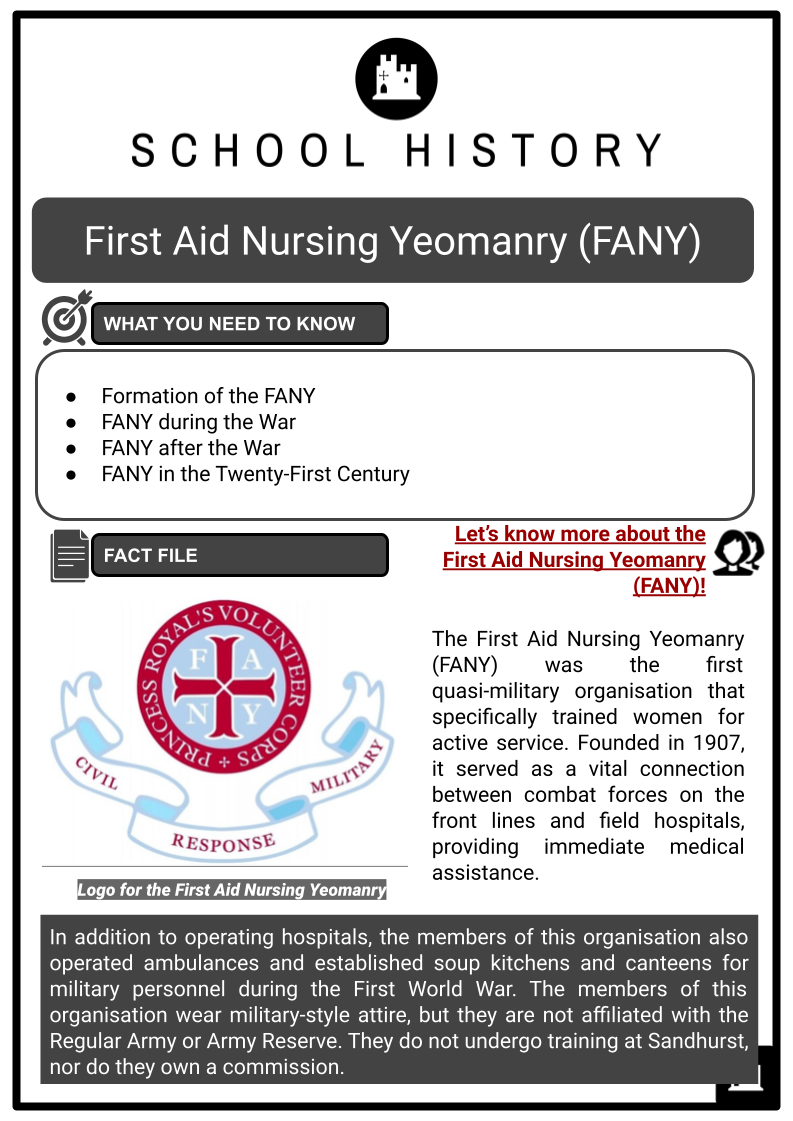
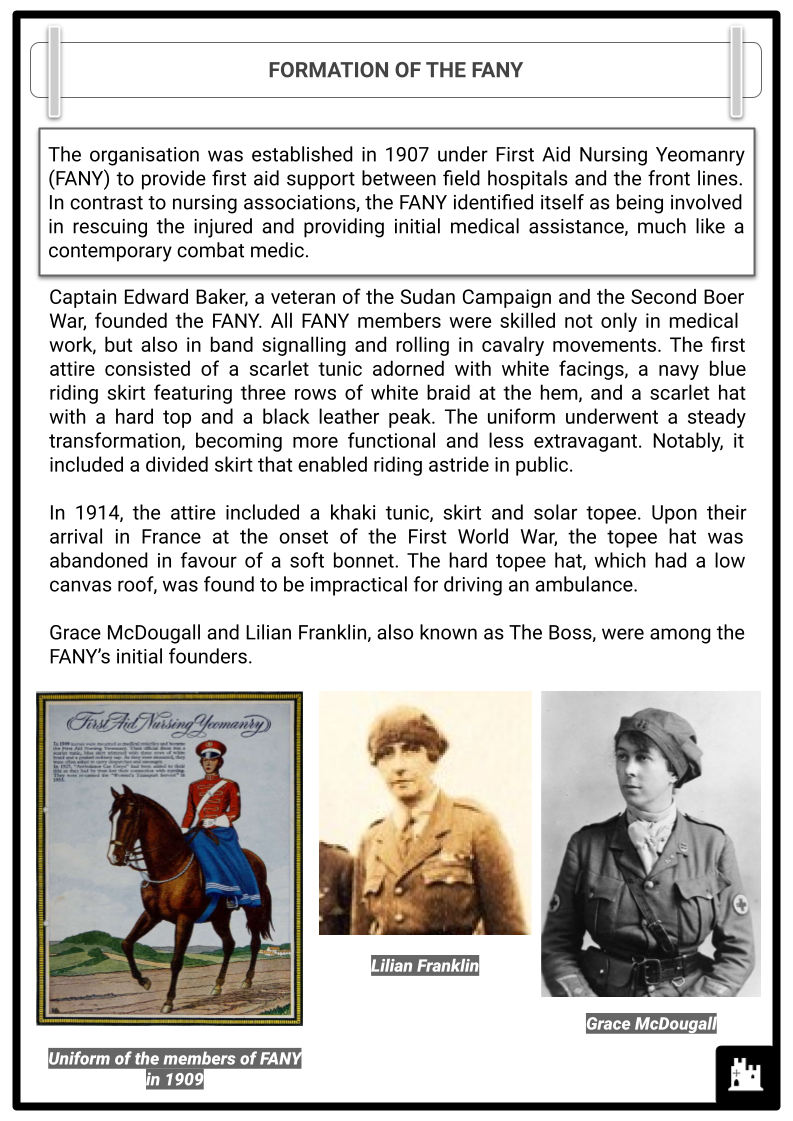
Student Activities
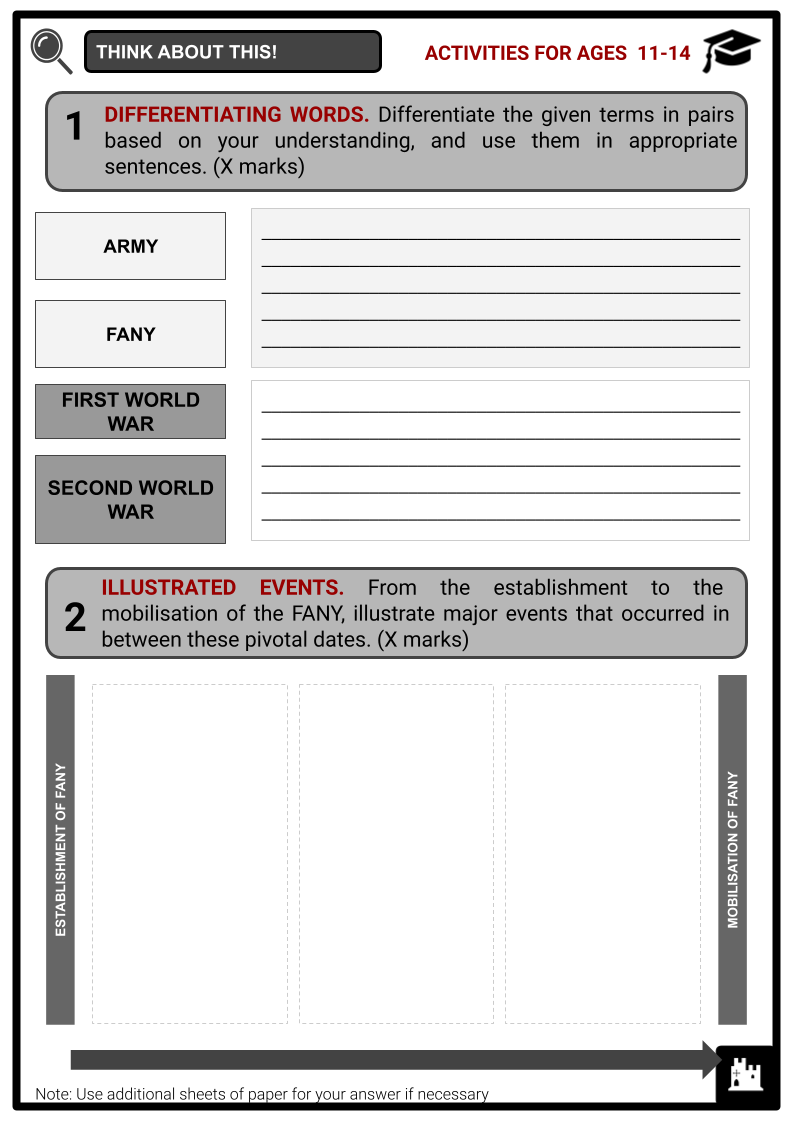
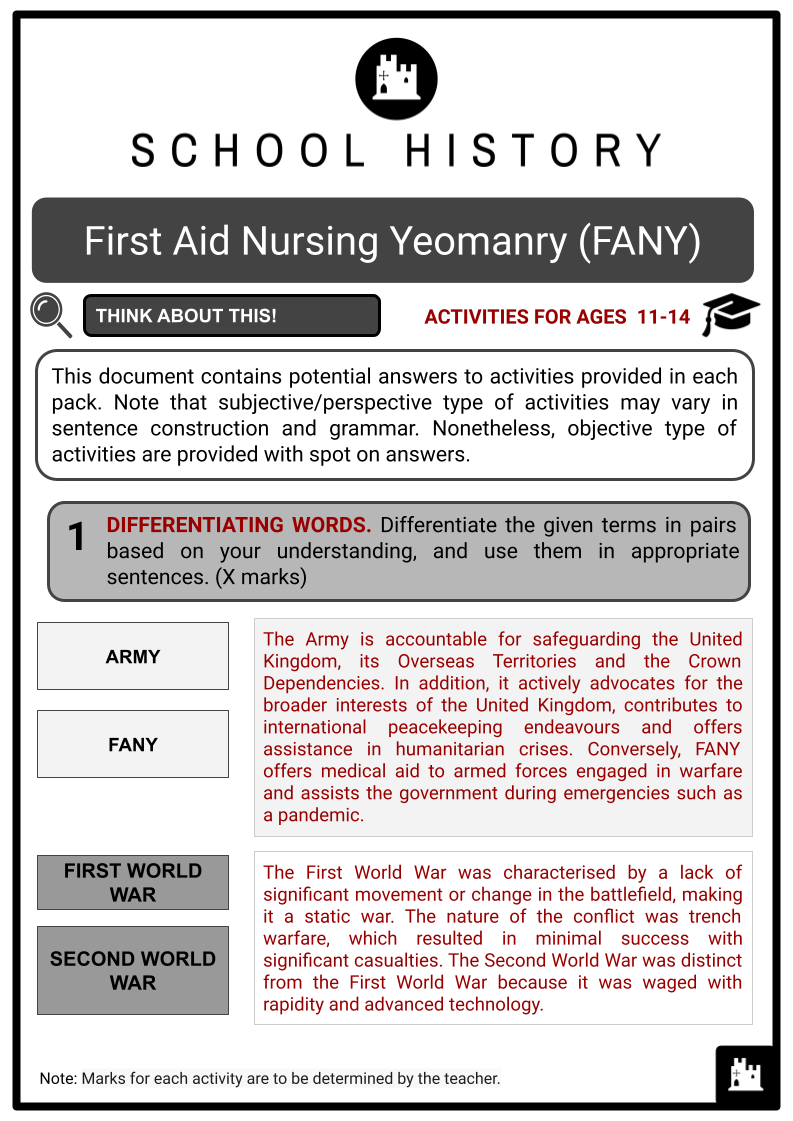
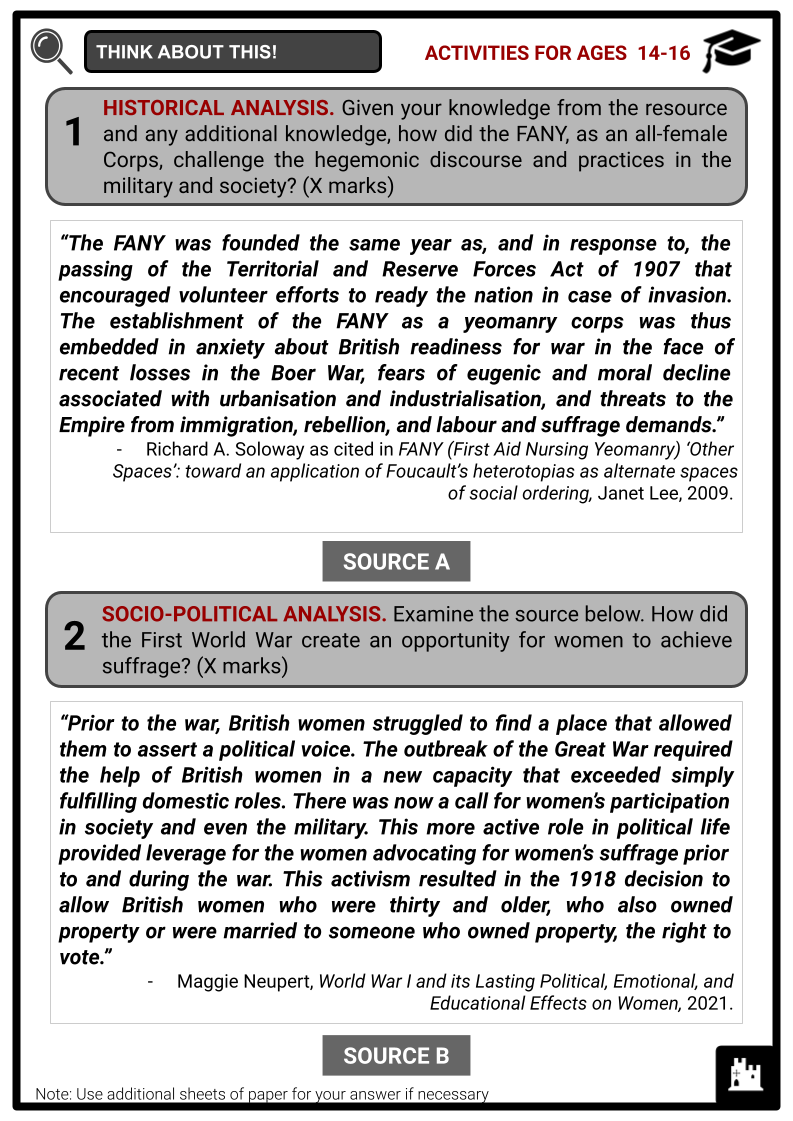
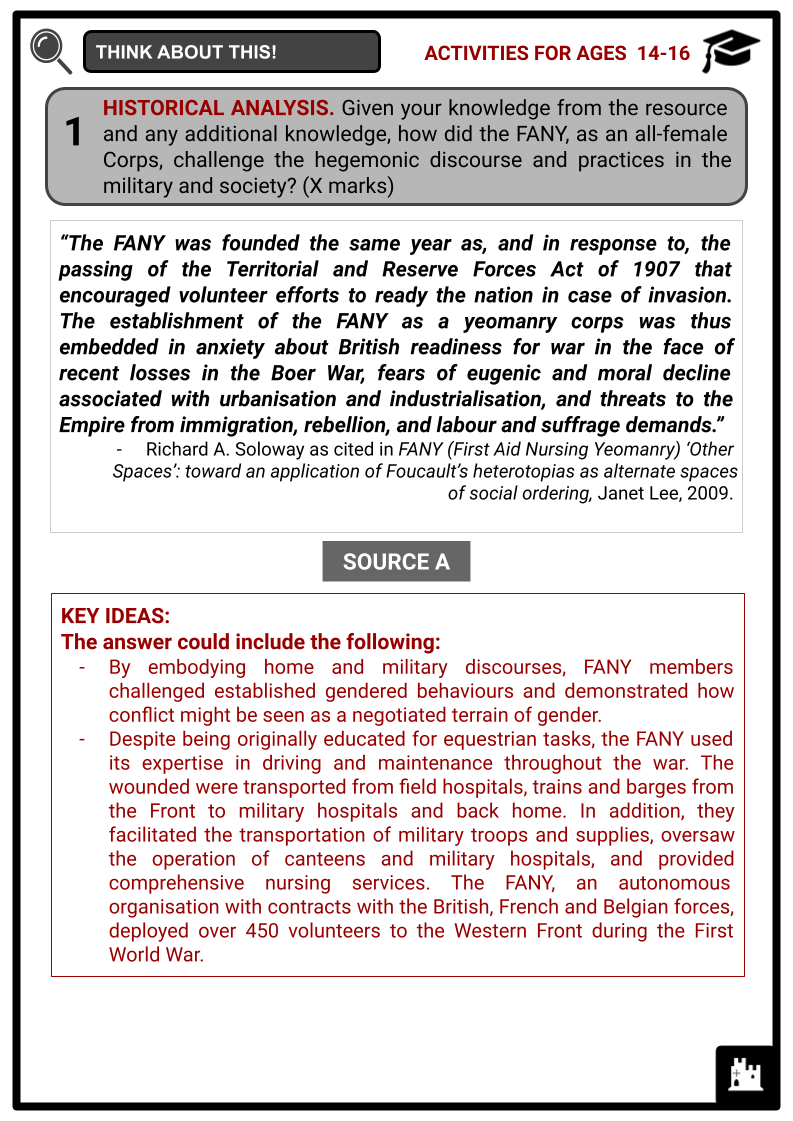
Summary
- Formation of the FANY
- FANY during the War
- FANY after the War
- FANY in the Twenty-First Century
Key Facts And Information
Let’s know more about the First Aid Nursing Yeomanry (FANY)!
The First Aid Nursing Yeomanry (FANY) was the first quasi-military organisation that specifically trained women for active service. Founded in 1907, it served as a vital connection between combat forces on the front lines and field hospitals, providing immediate medical assistance. In addition to operating hospitals, the members of this organisation also operated ambulances and established soup kitchens and canteens for military personnel during the First World War. The members of this organisation wear military-style attire, but they are not affiliated with the Regular Army or Army Reserve. They do not undergo training at Sandhurst, nor do they own a commission.
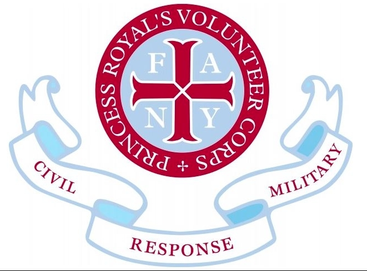
FORMATION OF THE FANY
- The organisation was established in 1907 under First Aid Nursing Yeomanry (FANY) to provide first aid support between field hospitals and the front lines. In contrast to nursing associations, the FANY identified itself as being involved in rescuing the injured and providing initial medical assistance, much like a contemporary combat medic.
- Captain Edward Baker, a veteran of the Sudan Campaign and the Second Boer War, founded the FANY. All FANY members were skilled not only in medical work, but also in band signalling and rolling in cavalry movements. The first attire consisted of a scarlet tunic adorned with white facings, a navy blue riding skirt featuring three rows of white braid at the hem, and a scarlet hat with a hard top and a black leather peak. The uniform underwent a steady transformation, becoming more functional and less extravagant. Notably, it included a divided skirt that enabled riding astride in public.
- In 1914, the attire included a khaki tunic, skirt and solar topee. Upon their arrival in France at the onset of the First World War, the topee hat was abandoned in favour of a soft bonnet. The hard topee hat, which had a low canvas roof, was found to be impractical for driving an ambulance.
- Grace McDougall and Lilian Franklin, also known as The Boss, were among the FANY’s initial founders.
FANY DURING THE WAR
- In 1914, women had few opportunities. The prevailing patriarchal structure of society led to the dominance of males, who believed that women should primarily occupy the domestic sphere. Consequently, there was a limited acceptance of the idea that women should be part of the FANY.
First World War
- On 27 October 1914, a group of six FANYs, consisting of Lieutenants Franklin and McDougall, three trained nurses and two male orderlies, travelled to Calais, France’s leading passenger port, after the War Office rejected their offer to help as paramedics. Subsequently, a privately sponsored motor ambulance arrived shortly after.
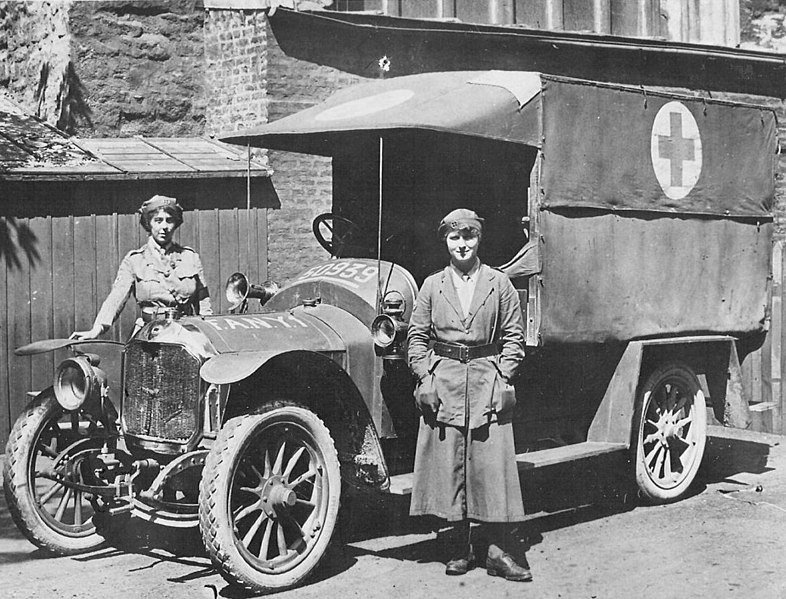
- The Belgian Army warmly received them, and over the following two years, the FANYs operated ambulances, established a hospital and two recovery facilities, and established a casualty clearing station in close proximity to the Front. Upon witnessing this, the resistance from British officials weakened significantly.
- Consequently, on 1 January 1916, the FANY became the first women to be formally authorised to drive for the British Army. This was made possible by the creation of an ambulance unit in Calais.
- The British were responsible for transporting deceased and critically injured individuals from clearing posts to hospitals and medical ships. Subsequently, other convoys were organised to support the French Army, which was stationed in the southern sector of the Front, close to Verdun.
- During the Armistice, the FANY received numerous commendations for their courageous actions. While many FANYs sustained injuries during their service in France, only one member died while serving with the French. The French laid her to rest with complete military honours in Sézanne.
- The FANY was also considered a mounted unit raised to assist with retrieving casualties from the field of battle. The Household Brigade supplied horses and equitation schooling, and the Foot Guards provided drill instructors.
- Their service was recognised by the award of 17 Military Medals, 18 Mentioned in Dispatches, 2 OBE and 3 MBE; 2 Order of the Crown (Chevalier), 7 Order of Leopold (Chevalier), 7 Decoration Civique, 1 Yser Medal and 38 Medaille de la Reine Elizabeth; 1 Legion d’Honneur (Chevalier) and 31 Croix de Guerre (1 with Palm Leaf: 16 with Bronze Star: 10 with Silver Star: 6 without additions).
Interwar Years
- Despite the FANY’s ongoing training to be prepared for providing emergency relief, it took several years for them to receive official recognition. Nevertheless, the War Office offered Army lodging and training support for Annual Camps.
- During the General Strike of 1926, the FANY Corps offered transport services and drivers to escort War Office personnel to and from their residences. The effectiveness of this dedication, along with a desire to consistently offer its services to the War Office for transportation tasks during times of national crisis both domestically and internationally, resulted in an official announcement in Army Orders and the inclusion of the FANY Corps in the monthly Army List. The title of the Corps was modified, resulting in a temporary renaming of the Corps to Ambulance Car Corps (FANY).
- In 1933, Her Royal Highness Princess Alice, Countess of Athlone, assumed the role of President of the Corps. Prior to the funeral of King George V in 1936, the London Section volunteered to provide their services as staff car drivers and message bearers to the Commanding Officer of the Royal Army Service Corps at Kensington Barracks. In 1937, the Corps changed its designation to Women’s Transport Service (WTS) (FANY).
Second World War
- At the onset of the war, the FANY was led by Mary Baxter Ellis, who had previously served with the Corps during the First World War. Helen Gwynne-Vaughan held the inaugural position of Chief Controller in the recently established Auxiliary Territorial Service (ATS).
- Ellis declined this post as she preferred to lead the FANY. However, she consented to provide 1,500 FANY motor mechanics to serve with the ATS, provided that these FANYs could operate autonomously.
- A self-governing FANY headquarters operated concurrently in London. The members of the FANY were referred to as the Free FANYs, and they had the privilege of wearing their uniform without any restrictions.
- One important role of the FANY during the Second World War was their involvement with the Special Operations Executive (SOE). FANYs joined the SOE in 1940 due to the connection between Phyllis Bingham, the secretary to the Corps commander at the time, and Colonel Colin Gubbins, the Director of Operations and Training for the SOE.
- The FANY’s service originated from their participation in the covert Auxiliary Units established in 1940 as a contingency force in the event of an invasion. After the war, more than 3,000 FANYs had contributed to the efforts of SOE in various roles, such as trainers, coders, signallers, forgers, dispatchers and, notably, agents.
- They engaged in coding and signal processing, serving as facilitators for agents and offering administrative and technical assistance for the Special Training Schools. Their job was classified as confidential and frequently required advanced expertise.
- The FANY personnel were deployed in several conflict zones, including North Africa, Italy, India and the Far East. A division was allocated to the Polish Army, mostly stationed at Linlithgow, where they supplied the Polish soldiers with attire, arms, automobiles, supplies, sustenance, administrative support and chauffeur services.
- The Kenyan Section, established in 1931, was designated as the official East African unit by the War Office in August 1941 and played a highly active role during the war. This part attracted women from various regions in the southern portion of Africa. Additional FANYs were affiliated with the British Red Cross, the American Ambulance Corps, and the French Committee for the French Red Cross.
- In 1944, a substantial contingent was dispatched to the Indian subcontinent and the Far East under the command of South East Asia Command.
FANY AFTER THE WAR
- In December 1945, the headquarters of WTS (FANY) relocated to 55 Sloane Street, SW3, where the premises served as an office and a residential club. On 8 June 1946, a group of 30 members of the FANY participated in the Victory Parade. The Cold War significantly impacted the training programmes, with a particular emphasis on Civil Defence. In 1957, the Corps commemorated the 50th anniversary of its establishment, and Commandant MacLellan was honoured with the Order of the British Empire (OBE).
- In 1960, the training organisation was substantially restructured in collaboration with the Royal Corps of Signals. In addition to the Annual Camp, a weekend signals training programme was implemented. A younger group of recruits was enlisted to establish the new Section, the No. 1 Independent Section. They underwent regular training with the SAS until May 1962, focusing on wireless telegraphy training at Worship Street and shooting practice at the Indoor Range located at White City Barracks.
- Corps Commander MacLellan retired in February 1965 after designating Sheila Parkinson as her successor. Parkinson had joined the Kenya FANYs in 1937. In the subsequent year, the newly appointed Chief Officer was tasked with locating a new facility to serve as the organisation’s headquarters.
- In 1969, a recruitment advertisement was published in newspapers, offering training for a new position in the event of a Metropolitan or National emergency. The purpose of establishing the Language Unit was to assemble many linguists who may offer their services as interpreters for international events, individually or in teams.
- By the early 1970s, the Language Group had achieved fluency in 12 languages. The FANY was requested to deploy a mobile Radio Telephone (RT) communications team to collaborate with the Provost Section, which was in charge of organising a significant march consisting of 800 individuals and 200 vehicles in Hyde Park.
- Her Royal Highness Princess Alice passed away in 1981 and was succeeded by Anne. In 1982, the Army Board granted the FANYs permission to train in operating Army Communication Centres (ACCs) during periods of stress or national emergency. The training commenced in the subsequent year.
FANY IN THE TWENTY-FIRST CENTURY
- The FANY was renamed Princess Royal’s Volunteer Corps (PRVC) in 1999 after Princess Anne took over the Commandant-in-Chief position in 1981. Currently, the Corps prioritises the deployment of specialised fast-reaction teams to provide assistance to civil and military authorities during crises. In 2020, all training was put on hold due to the COVID-19 pandemic, but the FANY (PRVC) has been called to operational duty to help respond to the crisis.
- The FANY (PRVC) was one of the 2021 winners of the prestigious Queen’s Award for Voluntary Service. The award recognises outstanding community work among local volunteer groups across the United Kingdom. FANY is the oldest and most established voluntary group for women in uniform and the sole remaining all-female unit in the United Kingdom. All members of the Corps are unpaid volunteers who must pay an annual subscription fee to be part of the Corps. Additionally, they must maintain a specified level of training.
Frequently Asked Questions
- What is the First Aid Nursing Yeomanry (FANY)?
The First Aid Nursing Yeomanry (FANY) is a British voluntary organisation that provides medical and logistical support during times of conflict, disaster, and emergency. It was founded in 1907 and has a long history of service.
- What are some notable achievements of FANY?
FANY has a distinguished history of service, including its contributions during both World Wars and various humanitarian crises.
- How does FANY contribute to military efforts?
FANY has a historical association with the military, dating back to its origins as a women's volunteer unit during World War I. Today, FANY supports military operations by providing medical and logistical assistance when needed.
